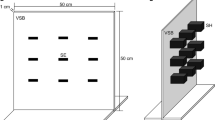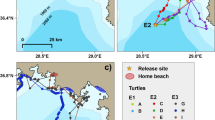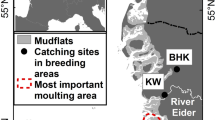Abstract
Males of the nocturnal spider Leucorchestris arenicola (Araneae: Sparassidae) wander long distances over seemingly featureless dune surfaces in the Namib Desert searching for females. The spiders live in burrows to which they return after nearly every such excursion. While the outward path of an excursion may be a meandering search, the return path is often a nearly straight line leading towards the burrow. This navigational behaviour resembles that of path integration known from other arthropods, though on a much larger scale (over tens to hundreds of meters). Theoretically, precise navigation by path integration over long distances requires an external compass in order to adjust for inevitable accumulation of navigational errors. As a first step towards identifying any nocturnal compass cues used by the male spiders, a method for detailed 3-D recordings of the spider’s paths was developed. The 3-D reconstructions of the paths revealed details about the processes involved in the spiders’ nocturnal way of navigation. Analyses of the reconstructed paths suggest that gravity (slope of the dune surface) is an unlikely parameter used in path integration by the L. arenicola spiders.






Similar content being viewed by others
References
Bartels M (1929) Sinnesphysiologische und physiologische Untersuchungen an der Trichterspinne Agelena labyrinthica (Cl.). Z Vergl Physiol 10:527–591
Barth FG (2002) A spider’s world, senses and behavior. Springer, Berlin Heidelberg NewYork
Benhamou S, Séguinot V (1995) How to find one’s way in the labyrinth of path integration models. J Theor Biol 174:463–466
Benhamou S, Sauvé JP, Bovet P (1990) Spatial memory in large-scale movements: efficiency and limitations of the egocentric coding process. J Theor Biol 145:1–12
Boles LC, Lohmann KJ (2003) True navigation and magnetic maps in spiny lobsters. Nature 421:60–63
Brownell PH (1977) Compressional and surface waves in sand: used by desert scorpions to locate prey. Science 197:479–482
Brownell PH (2001) Sensory ecology and orientational behaviors. In: Brownell PH, Polis GA (eds) Scorpion biology and research. Oxford University Press, pp 159–183
Collett M, Collett TS, Wehner R (1999) Calibration of vector navigation in desert ants. Curr Biol 9:1031–1034
Dacke M, Nilsson D-E, Warrant EJ, Blest AD, Land MF, O’Carroll DC (1999) Built-in polarizers form part of a compass organ in spiders. Nature 401:470–473
Dyer FC (1996) Spatial memory and navigation by honeybees on the scale of the foraging range. J Exp Biol:199:147–154
Frier HJ, Edwards E, Smith C, Neale S, Collett TS (1996) Magnetic compass cues and visual pattern learning in honeybees. J Exp Biol 199:1353–1361
Frisch K von (1967) The dance language and orientation of bees. The Belknap Press of Harvard University Press, Cambridge, Massachusetts
Fukushi T (2001) Homing in wood ants, Formica japonica: use of the skyline panorama. J Exp Biol 204:2063–2072
Gal J, Horvath G, Barta A, Wehner R (2001) Polarization of the moonlit clear night sky measured by full-sky imaging polarimetry at full moon: comparison of the polarization of moonlit and sunlit skies. J Geophys Res D19 106:22647–22653
Görner P, Class B (1985) Homing behavior and orientation in the funnel-web spider, Agelena labyrinthica Clerck. In: Barth FG (ed) Neurobiology of arachnids. Springer, Berlin Heidelberg New York, pp 275–297
Henschel JR (1987) Sand-burrowing spiders: how do they do it? Bull Desert Res Unit 7:11
Henschel JR (1990a) The biology of Leucorchestris arenicola (Araneae: Heteropodidae), a burrowing spider of the Namib Desert. In: Seely MK (ed) Namib ecology: 25 years of Namib research. Transvaal Museum monograph no. 7. Transvaal Museum, Pretoria, pp 115–127
Henschel JR (1990b) Spiders wheel to escape. S Afr J Sci 86:151–152
Henschel JR (1994) Diet and foraging behaviour of huntsman spiders in the Namib dunes (Araneae: Heteropodidae). J Zool (Lond) 234:239–251
Henschel JR (2002) Long distance wandering and mating by the dancing white lady spider (Leucorchestris arenicola) (Araneae, Sparrassidae) across Namib dunes. J Arachnol 30:321–330
Hill DE (1979) Orientation by jumping spiders of the genus Phidippus (Araneae: Salticidae). Behav Ecol Sociobiol 5:301–322
Jäger P (1999) Sparassidae - the valid scientific name for the huntsman spiders (Arachnida: Araneae). Arachnol Mitt 17:1–10
Lawrence RF (1962) Spiders of the Namib Desert. Ann Transvaal Mus 10:197–211
Lawrence RF (1965) New and little known Arachnida from the Namib Desert, S.W. Africa. Sci Pap Namib Desert Res Stn 27:1–12
Menzel R, Geiger K, Joerges J, Müller U, Chittka L (1998) Bees travel novel homeward routes by integrating separately acquired vector memories. Anim Behav 55:139–152
Mittelstaedt H (1985) Analytical cybernetics of spider navigation. In: Barth FG (ed) Neurobiology of arachnids. Springer, Berlin Heidelberg New York, pp 298–316
Mittelstaedt H, Mittelstaedt ML (1982) Homing by path Integration. In: Papi F, Wallraff HG (eds) Avian navigation. International Symposium on Avian Navigation (ISAN), Tirrenia (Pisa). Springer, Berlin Heidelberg New York, pp 290–297
Mouritsen H, Frost BJ (2002) Virtual migration in tethered flying monarch butterflies reveals their orientation mechanisms. Proc Natl Acad Sci USA 99:10162–10166
Müller M, Wehner R (1988) Path integration in desert ants, Cataglyphis fortis. Proc Natl Acad Sci USA 85:5278–5290
Müller M, Wehner R (1994) The hidden spiral: systematic search and path integration in desert ants, Cataglyphis fortis. J Comp Physiol A 175:525–530
Papke MD, Reichert SE, Schultz S (2001) An airborne female pheromone associated with male attraction and courtship in a desert spider. Anim Behav 61:877–886
Pollard SD, Macnab AM, Jackson RR (1987) Communication with chemicals: pheromones and spiders. In: Nentwig W (ed) Ecophysiology of spiders. Springer, Berlin Heidelberg New York, pp 133–141
Rickli M, Leuthold RH (1988) Homing in harvester termites: evidence of magnetic orientation. Ethology 77:209–216
Robinson MD, Seely MK (1980) Physical and biotic environments of the southern Namib dune ecosystem. J Arid Environ 3:183–203
Rossel S, Wehner R (1984) Celestial orientation in bees: the use of spectral cues. J Comp Physiol A 155:605–613
Rossel S, Wehner R (1986) Polarization vision in bees. Nature 323:128–131
Seyfarth EA, Barth FG (1972) Compound slit sense organs on the spider leg: mechanoreceptors involved in kinesthetic orientation. J Comp Physiol 78:176–191
Seyfarth EA, Hergenröder R, Ebbes H, Barth FG (1982) Ideothetic orientation of a wandering spider: compensation of detours and estimates of goal distance. Behav Ecol Sociobiol 11:139–148
Srinivasan MV, Zhang SW, Lehrer M, Collett TS (1996) Honeybee navigation en route to the goal: visual flight control and odometry. J Exp Biol 199:237–244
Ugolini A, Pezzani A (1995) Magnetic compass and learning of the Y-axis (sea-land) direction in the marine isopod Idotea baltica basteri. Anim Behav 50:295–300
Vollrath F, Nørgaard T, Krieger M (2002) Radius orientation in the garden cross spider Araneus diadematus. In: Toft S, Scharff N (eds) Proceedings of the 19th European Colloquium of Arachnology, Aarhus 17–22 July 2000. Aarhus University Press, pp 107–116
Wehner R (1992) Arthropods. In: Papi F (ed) Animal Homing. Chapman and Hall, London, pp 45–144
Wehner R (1994) The polarization-vision project: championing organismic biology. Fortschr Zool 39:103–143
Wehner R (1997) The ant’s celestial compass system: spectral and polarization channels. In: Lehrer M (ed) Orientation and communication in arthropods. Birkhäuser, Basel, pp 145–185
Wehner R, Duelli P (1971) The spatial orientation of desert ants, Cataglyphis bicolor, before sunrise and after sunset. Experientia 27:1364–1366
Wehner R, Wehner S (1986) Path integration in desert ants. Approaching a long-standing puzzle in insect navigation. Monit Zool Ital 20:309–331
Wehner R, Wehner S (1990) Insect navigation: use of maps or Ariadne’s thread? Ethol Ecol Evol 2:27–48
Wehner R, Harkness RD, Schmid-Hempel P (1983) Foraging strategies in individually searching ants, Cataglyphis bicolor (Hymenoptera: Formicidae). Akad Wiss Lit Mainz Abh Math Naturwiss Kl. Fischer, Stuttgart
Wehner R, Michel B, Antonsen P (1996) Visual navigation in insects: coupling of egocentric and geocentric information. J Exp Biol 199:129–140
Wehner R, Gallizzi K, Frei C, Vesely M (2002) Calibration processes in desert ant navigation: vector courses and systematic search. J Comp Physiol A 188:683–693
Wohlgemuth S, Ronacher B, Wehner R (2001) Ant odometry in the third dimension. Nature 411:795–798
Wohlgemuth S, Ronacher B, Wehner R (2002) Distance estimation in the third dimension in desert ants. J Comp Physiol A 188:273–281
Zar JH (1999) Biostatistical analysis. Prentice-Hall, London
Acknowledgements
We thank the Gobabeb Training and Research Centre and the Ministry of Environment and Tourism for permission to work in the Namib-Naukluft Park, the Swiss National Science Foundation for funding the project (grant no. 31-61844.00 to R.W.), the Department of Zoology, University of Zürich, Switzerland and the Department of Zoology, University of Aarhus, Denmark, for equipment and infrastructural support. We are grateful also to Torben Geilman and Klaus Birkhofer for valuable help and fruitful discussions. This fieldwork complies with Namibian law.
Author information
Authors and Affiliations
Corresponding author
Rights and permissions
About this article
Cite this article
Nørgaard, T., Henschel, J.R. & Wehner, R. Long-distance navigation in the wandering desert spider Leucorchestris arenicola: can the slope of the dune surface provide a compass cue?. J Comp Physiol A 189, 801–809 (2003). https://doi.org/10.1007/s00359-003-0455-6
Received:
Revised:
Accepted:
Published:
Issue Date:
DOI: https://doi.org/10.1007/s00359-003-0455-6




